Discover 11 hidden attractions, cool sights, and unusual things to do in Sycamore (United States). Don't miss out on these must-see attractions: Sycamore Public Library, Civil War Memorial, and Midwest Museum of Natural History. Also, be sure to include Elmwood Cemetery Gates in your itinerary.
Below, you can find the list of the most amazing places you should visit in Sycamore (Illinois).
Table of Contents
Sycamore Public Library

Public library in Sycamore, Illinois. The Sycamore Public Library, in Sycamore, Illinois, was erected in 1905 in the former location of Mansion House, Sycamore's oldest structure. Construction began in May of that year and the library officially opened to the public on Thanksgiving Day, 1905. The library joined the National Register of Historic Places in May 1978 with the rest of the Sycamore Historic District. The library still operates, as of 2019, as the Sycamore library. The library was erected with the help of a $10,000 grant from Andrew Carnegie in 1905.[1]
Address: 103 E State St, 60178 Sycamore
Civil War Memorial
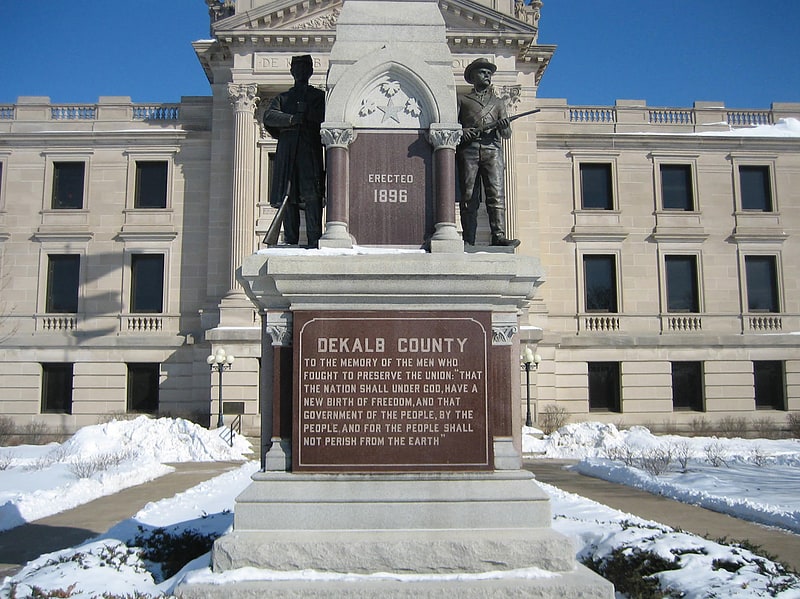
The Civil War Memorial, in the DeKalb County county seat of Sycamore, Illinois, United States, is located in front of the DeKalb County Courthouse on a public square. The memorial was erected in 1896 and dedicated in 1897. The structure is a memorial to the thousands of DeKalb County residents who served in the American Civil War. It incorporates an obelisk which rises to 50 feet in height. The base is adorned with copper sculpture, completed by an unknown sculptor. On the east facade of the memorial the word "Antietam", denoting the Battle of Antietam, is misspelled. This work of public art underwent its first restoration work in 2005-2006.
The memorial is included among the 187 buildings and structures considered contributing properties to the Sycamore Historic District. The historic district was added to the U.S. National Register of Historic Places in 1978. The structure also has artistic significance as it is listed by the Smithsonian American Art Museum in their research database. It is one of the few sculptures in DeKalb County found within that database. The Civil War Memorial is owned by DeKalb County.[2]
Midwest Museum of Natural History
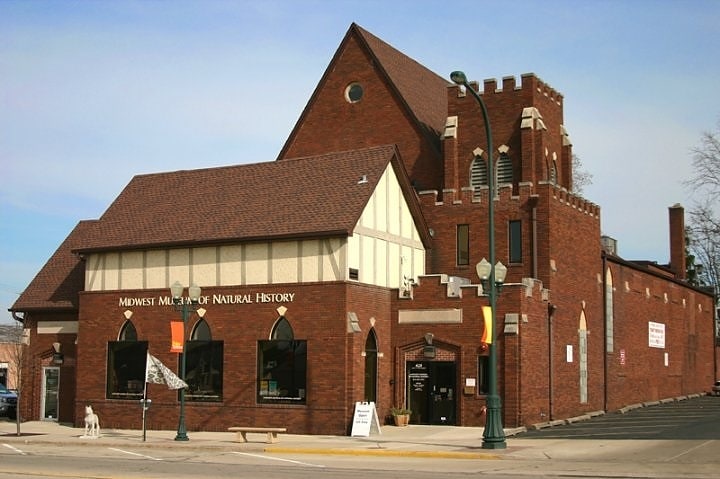
The Midwest Museum of Natural History was a 5013 organization located in Sycamore, Illinois, United States. In 1875, the structure was built as the home of the Universalist Church in Sycamore. In the 1920s the building underwent dramatic changes, becoming the Sycamore Community Center, complete with basketball courts, a swimming pool, and hip hangout, Teen Town. In February 2004, this 129-year-old building was overhauled once again with a top-to-bottom 1.2 million dollar renovation. This included the creation of exhibit halls, classrooms, offices, collection storage, and a new roof and climate controls to help preserve Museum specimens. The museum closed permanently in February of 2020.[3]
Address: 425 W State St, 60178 Sycamore
Elmwood Cemetery Gates
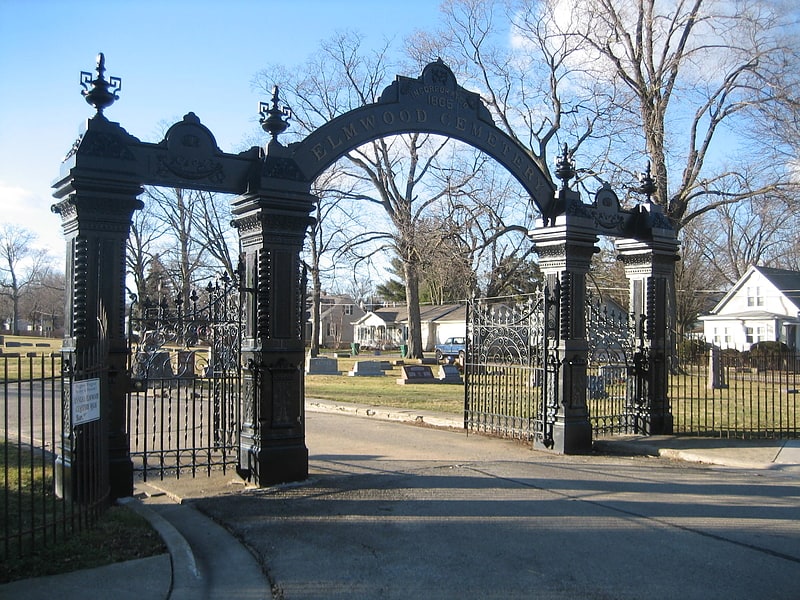
The Elmwood Cemetery Gates mark the east and north entrances to the Elmwood Cemetery in Sycamore, Illinois. The cast iron gates were likely built in 1865, the year the cemetery opened and the one emblazoned on the gates, though records of their construction have been lost. While cast iron was commonly used for building facades at the time, the gates are a rare example of its use in landscape architecture. The gates have a Serlian design with a wide central road entry and narrower pedestrian gates on either side; square columns separate the gates. An arch bearing the cemetery's name rises above the center entrance, while lintels span the side entrances; both the arch and the lintels feature ornamental designs. The Illinois Historic Structures Survey described the gates as the best extant example of iron cemetery gate design in the state.
A number of prominent past citizens of both Sycamore and nearby DeKalb are buried in the cemetery.
The gates have been listed on the National Register of Historic Places since November 28, 1978.[4]
DeKalb County Courthouse
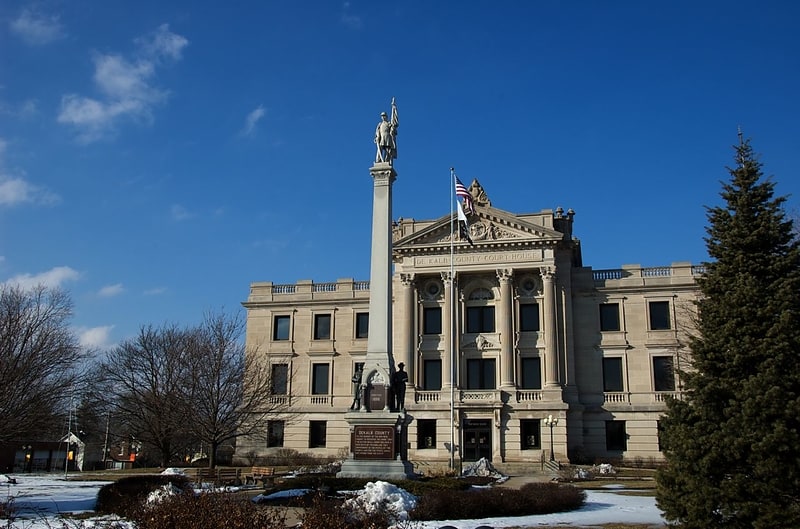
Courthouse. The DeKalb County Courthouse is located in the county seat of DeKalb County, Illinois, U.S. the city of Sycamore. The Classical Revival structure sits on a square facing Illinois Route 64 as it passes through the city. The current courthouse was constructed in 1905 amid controversy over where the courthouse and thus, ultimately, the county seat would be located. The current building is the third structure to bear the name "DeKalb County Courthouse." DeKalb County's Courthouse still serves as the county's primary judicial center and is a contributing property to the Sycamore Historic District. The district joined the National Register of Historic Places in 1978. As the county's primary courthouse for over 100 years, the site has been host to many trials, including prominent murder cases.
The building is cast in the Classical Revival architectural style and contains elements common to that style. Stained glass, columns and a pediment are among the more noticeable features at a glance. The rear facade of the building is designed to resemble a temple and also features stained glass windows. A stone porte-cochere covers the rear driveway. Inside the building's third floor courtroom is more stained glass, in the form of a skylight. During the early 1980s a made for television movie had scenes filmed in the DeKalb County Courthouse's courtroom.[5]
Carlos Lattin House
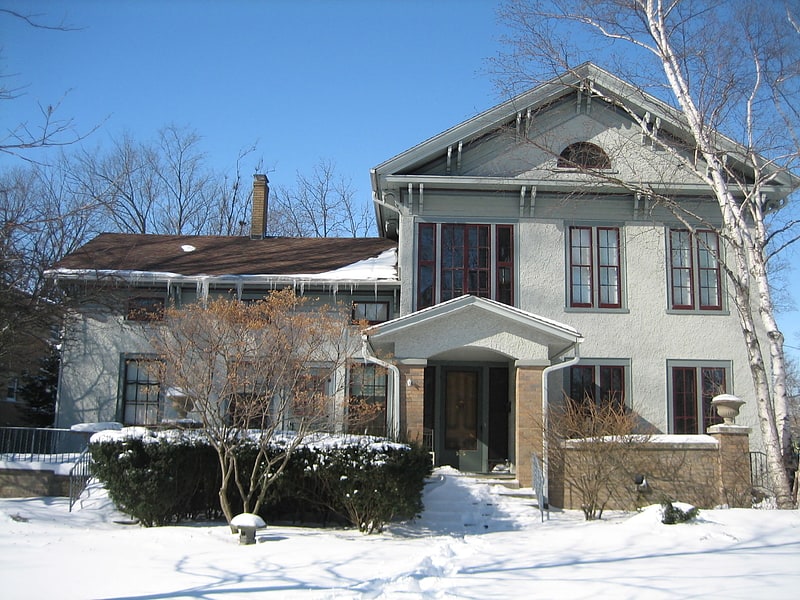
The Carlos Lattin House was built by Sycamore, Illinois' first permanent settler, Carlos Lattin. It lies within the boundaries of the Sycamore Historic District and is listed as one of the contributing structures in the district. The Sycamore Historic District was added to the National Register of Historic Places in 1978.[6]
Charles O. Boynton Carriage House
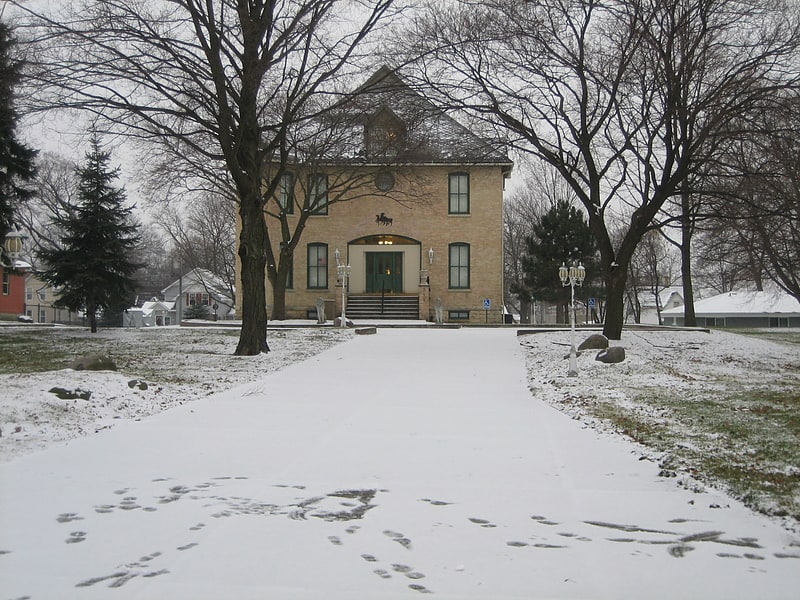
The Charles O. Boynton Carriage House is a prominent structure in the Sycamore Historic District, located in Sycamore, Illinois. The Sycamore Historic District was added to the National Register of Historic Places in 1978. The Carriage House is considered one of more than 150 contributing properties to the overall historic integrity of the district.[7]
Charles O. Boynton House
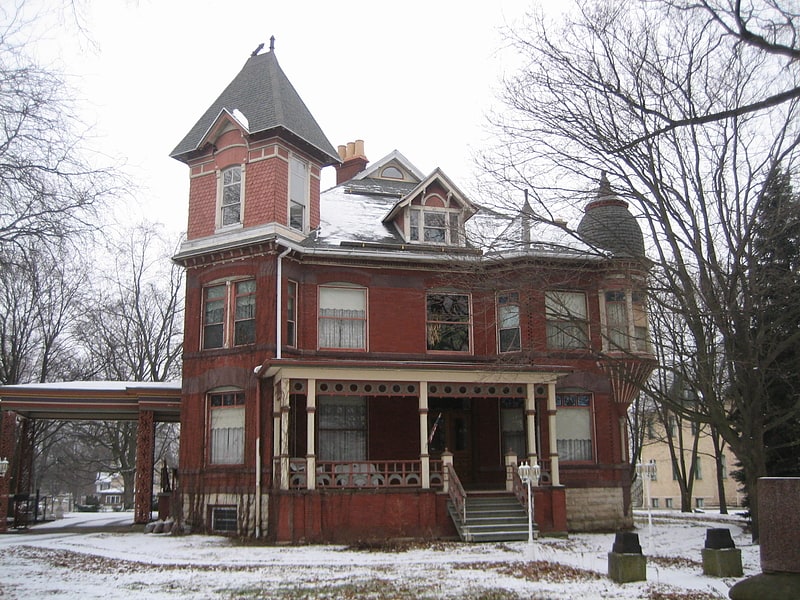
The Charles O. Boynton House is located in the DeKalb County, Illinois, city of Sycamore. The home is part of the Sycamore Historic District which was designated and listed on the National Register of Historic Places in May 1978. The Queen Anne style mansion sits on a stretch of Sycamore's Main Street that is dotted with other significant Historic District structures including, the Townsend House and the Townsend Garage. The Boynton House was designed by the same architect who designed the Ellwood House in nearby DeKalb and the David Syme House, another house in the Sycamore Historic District.[8]
D. B. James House
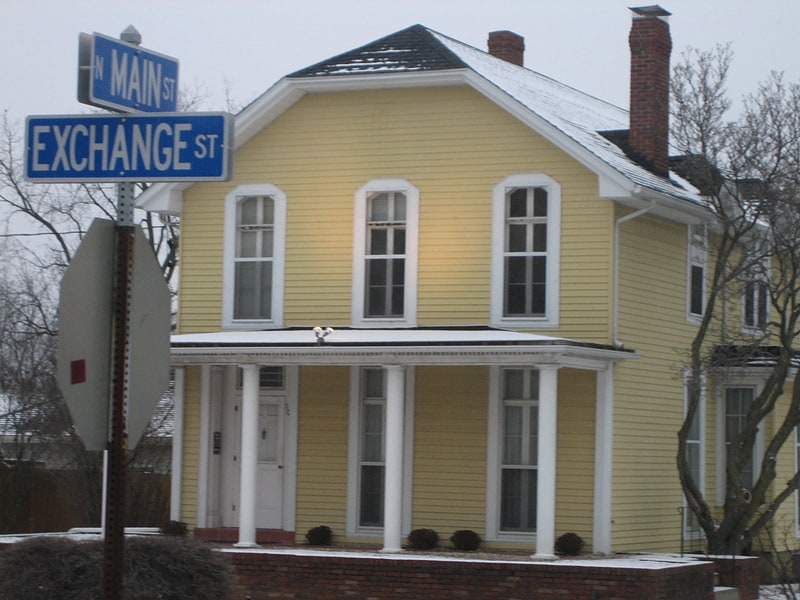
The D. B. James House is located in Sycamore, Illinois and is part of the Sycamore Historic District. The district was entered on the National Register of Historic Places in 1978. The James House is one of 226 properties located within the district boundaries. It stands on the corner of Exchange and Main Streets behind the DeKalb County Courthouse.[9]
Frederick B. Townsend House
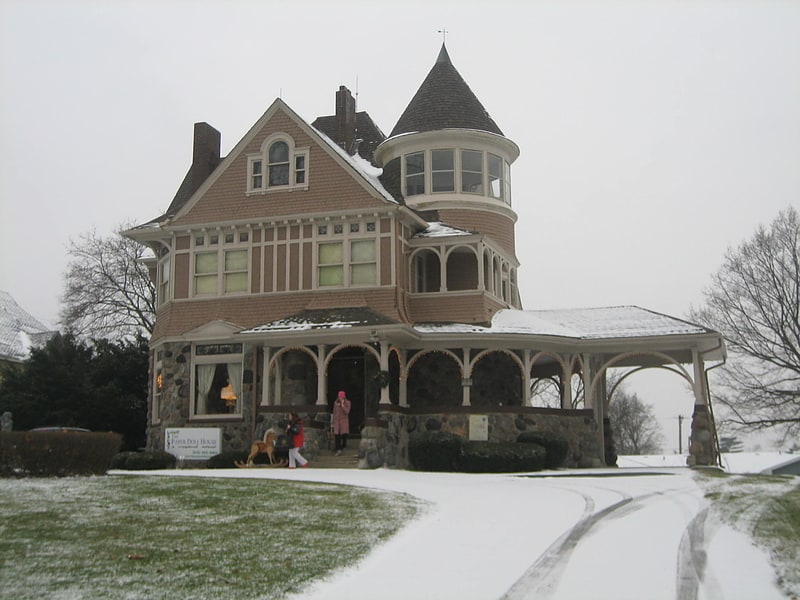
The Frederick B. Townsend House is located in the DeKalb County, Illinois county seat of Sycamore. The home is within the boundaries of the Sycamore Historic District. The district was designated and listed on the National Register of Historic Places in May 1978. The Queen Anne style home was designed and constructed in 1890 or 1892 by the same architect and general contractor responsible for Altgeld Hall at Northern Illinois University and the nearby DeKalb County Courthouse, as well as the courthouse in Lee County.[10]
Adolphus W. Brower House
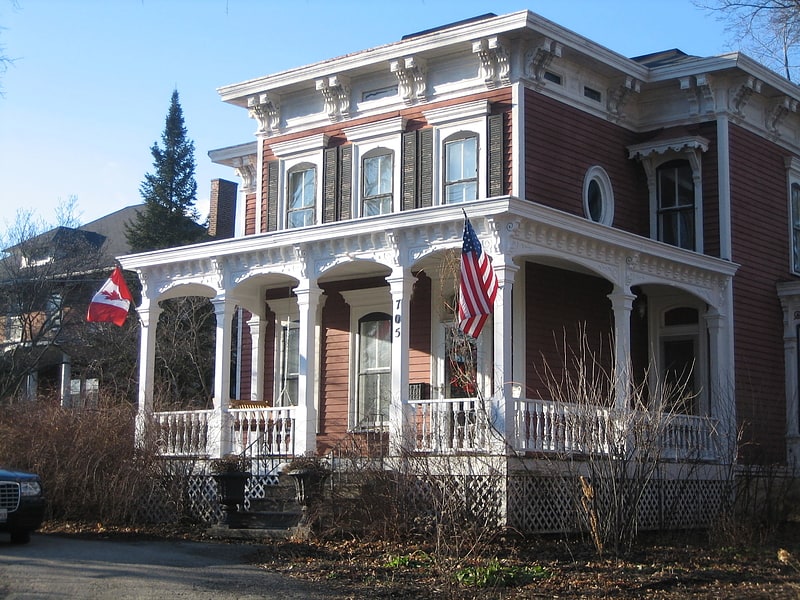
Heritage building in Sycamore, Illinois. The Adolphus W. Brower House, in Sycamore, Illinois, has been listed on the National Register of Historic Places since February 14, 1979. The home is located on Illinois Route 64 as it passes through the DeKalb County seat of Sycamore as DeKalb Avenue. The Italianate structure, constructed of stone and asphalt, was erected in 1876 by Sycamore merchant Adolphus W. Brower. It is also known as the George F. Beasley House.[11]